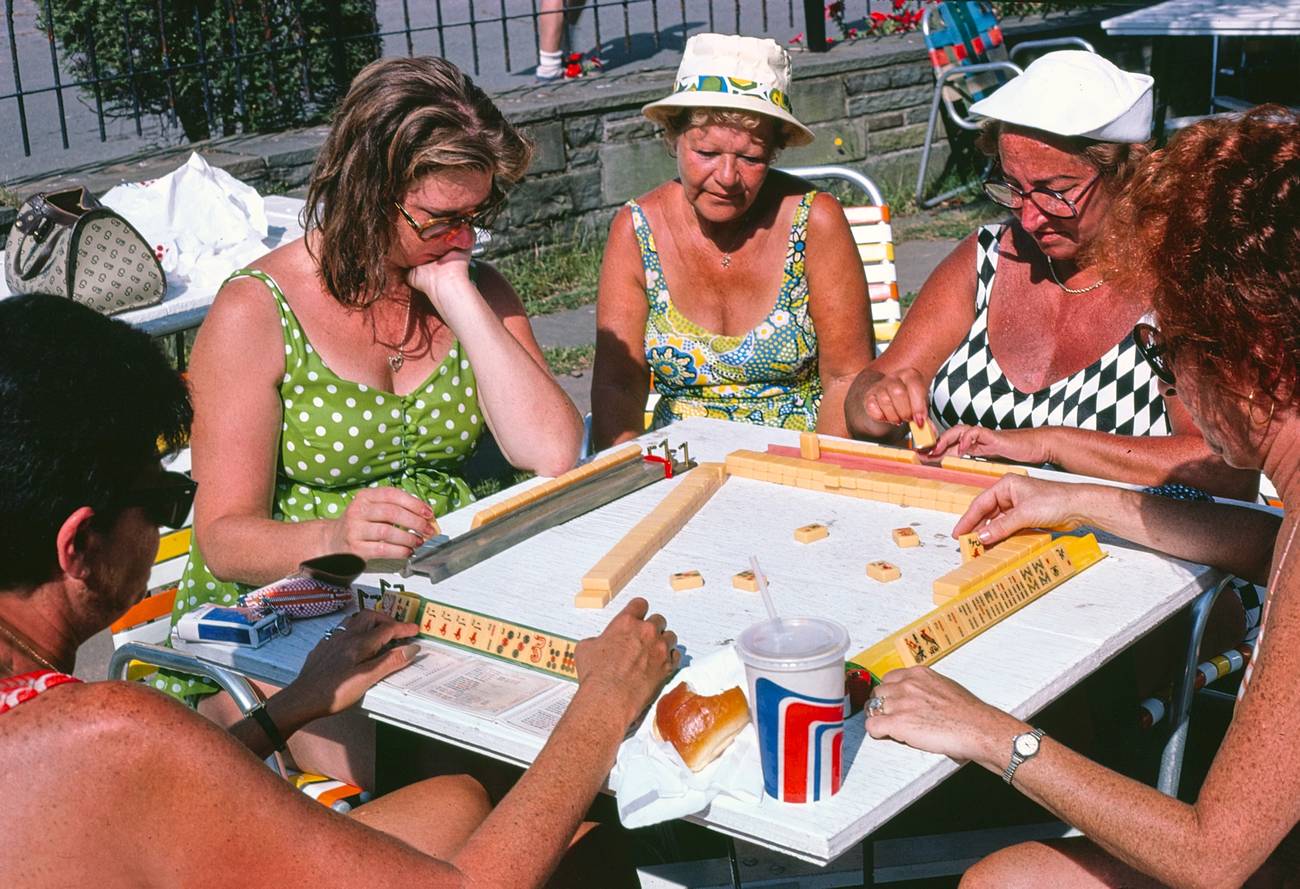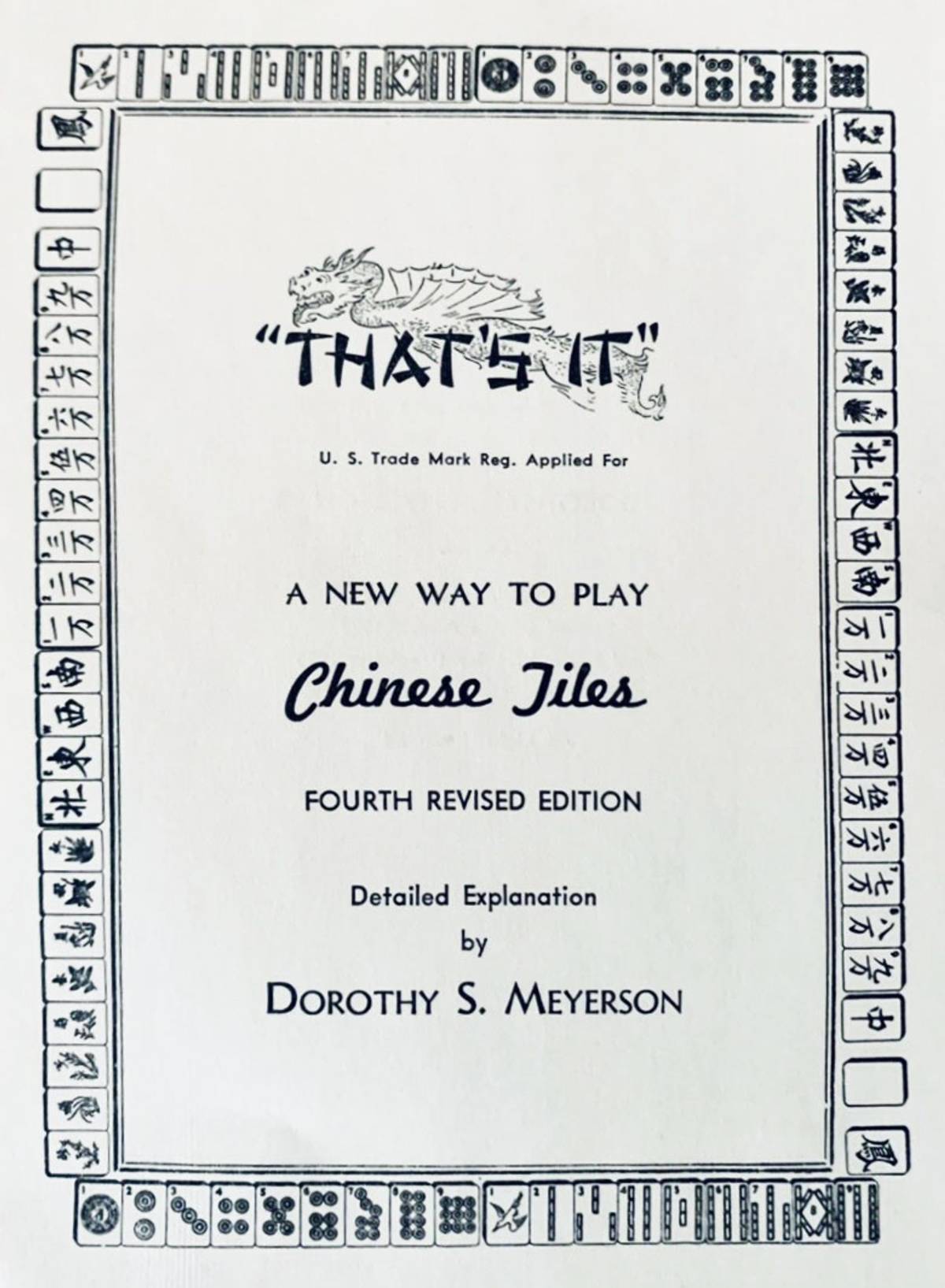How Mahjong Became American—and Jewish
The women behind the ‘national’ version of the Chinese game



In the fall of 1937, nearly 400 women (twice the expected number) crowded into the sumptuous hall of the Essex House hotel, its gilded art deco doors opening directly onto Central Park’s bright foliage. Ladies from across the New York region gathered to answer the call by Viola Cecil, president of the newly formed National Mah Jongg League and a resident of Essex House, to standardize the rules of the game. Many, though not all, were Jewish, including Cecil herself. The wealthier among them came from established families and lived either near the Essex, close to Columbus Circle, or in midtown and the Upper East Side. Others came from more modest but upwardly mobile communities in Brooklyn, the Bronx, or Long Island.
The packed hall vibrated with excitement as the attendees urged the league to make decisions that would unify a game that they felt had fractured over small differences from group to group. One impassioned speaker targeted a conflict over how groups collected the small betting amounts: “If you don’t standardize the rolling kitty, you’ll be caught with your pants down!” she cried. The league’s decisions would take the first steps toward creating a unique version of mahjong that set what they called “National Mah Jongg” on its own path, away from the Chinese game. In so doing, they created a consumer base that would drive the Americanization of mahjong manufacturing for decades to come.
The women who founded the National Mah Jongg League (NMJL) in 1937 aimed to standardize the game and thereby revitalize its popularity. Mahjong had never died out entirely, but by the 1930s its popularity in the United States was a pale shadow of the craze years a decade previous. During the years of depression, war, and postwar expansion, however, the game evolved in the United States and abroad, creating discrete national, regional, and community forms. In the 1940s, the wives of Air Force officers created their own version, which continued to spread across postwar bases. The most influential community adaptation by far was driven by the National Mah Jongg League. Although aiming for universality in their bid for success, their new game grew primarily through Jewish women’s networks, and, as with other versions of mahjong, it created new boundaries around communities of play. The league’s membership rolls quickly mushroomed to more than 35,000 by 1941. Over the ensuing decades, eventually hundreds of thousands of players, mostly but not exclusively Jewish American women, played their “national” version of the international Chinese game.
In creating a national version of mahjong, the league took a shared reference point from mahjong’s American past and transformed it into something new. When the league codified the first uniquely American style of play in the 1930s, it marked the cultural and physical Americanization of the game—a process that continued through the following decades as the American game became increasingly differentiated in rule and form. By the 1960s, their repeated changes had transformed the game enough that it required a different set of tiles. The changes to the game that the league initiated were enabled by their proximity to the small factories making the tiles, as one kind of Americanization helped enable another. After World War II the locus of mahjong manufacturing for the American market moved from China to plastic fabricating shops in New York City. The materiality of the game reflected its changing social meaning, as the plastic tiles lost their much-discussed “exotic” and artisanal materials even as they retained clear aesthetic markers of the game’s Chinese origins.
The league’s game initially solidified as a “simplified, faster, and more enticing” variant that built upon the earlier American rules. This new version was “streamlined,” a fashionable word borrowed from the curves of art moderne. These words of speed and sleekness revealed what the founders of the league considered the biggest obstacles of the original game: inconsistent variations dragged down by cumbersome scoring systems. Standardization around a simplified scoring system and fewer choices for winning hands, the league’s founders believed, could unite American players around their new “national” game and thereby regain widespread popularity.

One of the founders of the league, Dorothy Meyerson, laid an important foundation for the game’s development and its eventual spread among Jewish women in particular. The oldest daughter of a German American Jewish mother and a Russian immigrant father, the indefatigable Dorothy Meyerson exuded energy and was a natural performer. After marriage and motherhood, she focused on mahjong as a vehicle for creativity and public leadership, without jeopardizing her class status by engaging in paid work.
By the time she helped found the league in 1937, Meyerson had been promoting her “streamlined” form of the game for more than a year. Viola Cecil, another mahjong enthusiast, contacted her to help found the league in order to restore mahjong from social decline and fracture. Cecil, the wealthiest among the founders, became president and Meyerson vice president, a position she held for years. Meyerson already had a network of traveling agents for her rulebook That’s It! (named to evoke the exclamation of an excited winner). Her business’s growth coincided with—and certainly encouraged—a slow but more widespread renewal of interest in the game. Meyerson herself was a particularly skilled teacher, distributor, and promoter. Although she admitted, “No one person created the new way to play,” her version of the game was nearly identical to the form that the league adopted. She advertised it as an heir to the familiar “ancient game of the Mandarins,” as a “new American game made up of representative suggestions from different groups.” The independent but league-approved rulebooks written by Meyerson and Cecil would soon compete with each other for market share and would both promote the league’s official version as the “national” and “American” form.
Meyerson helped build an infrastructure for the game’s resurgence, particularly among middle-class and upper-middle-class women. Frequent patrons of department stores like Macy’s, these consumers not only shopped but also learned “the new way to play” mahjong at Meyerson’s free in-store lessons, which she conducted both before and after the founding of the league. Meyerson may not have needed additional income, but her agents, among the many women who worked as the foot soldiers of mass consumerism and distribution, did. As they had in the 1920s, department stores such as the Stearn Company in Cleveland and Bamberger’s in New Jersey hosted “clinics” where agents simultaneously taught customers Meyerson’s (and then the league’s) version, sold her rulebook That’s It! and the stores’ sets, and promoted an image of the game’s resurrection. “You ought to get around,” agent Mrs. Lee Goldman chastised a Cleveland News reporter who mistakenly viewed the game as “obsolete.” “I’ll bet everyone I know is playing mah jong again,” she told him.
While economic need did not drive Meyerson and other league founders, status aspirations did. As Meyerson’s daughter later explained, “Money was important, but it wasn’t the thing that was going to elevate her in society. She was in society in her own field”—a social arena she created through her public leadership of mahjong. Meyerson loved the spotlight; within the constraints of her social position as an affluent woman, she maximized media coverage and appeared on radio programs and even very early television. On Sunday evenings in the early 1940s, New York households that were part of the nation’s first experimental residential television systems could watch Meyerson teach the game with a “specially-enlarged Mah Jongg set.” An experienced teacher, she developed numerous techniques for effective instruction that also promoted sales of new products, including a “Practice While Learning” set of perforated cardboard tiles to accompany her instruction book.
In a key distinction from her entrepreneurial mahjong predecessors, Meyerson was a married mother of means. Lack of financial necessity provided a cloak of genteel femininity while she developed her business. Similarly, Viola Cecil veiled her extensive business-minded efforts, claiming that the league “just sprang up spontaneously.” Even as Meyerson aggressively marketed the game and wrote advertising copy in which she called herself the “world’s greatest authority on mahjong,” she deliberately presented herself as a devoted mother and, initially, as an accidental entrepreneur. “It seemed a shame to give it up,” she told a reporter in 1937, who described her as a “young, good-looking housewife” and a “careful mother” who was already teaching music and painting, volunteering with her synagogue sisterhood, serving as president of the Parent Teacher Association, and making sure her children had a good lunch each day. The article did not discuss the live-in nanny who helped enable Meyerson’s expansive commitments. Unlike the original experts, Meyerson’s authority as a mahjong expert did not rest on any connection to China, nor on an established reputation with games such as bridge. Instead, her role as mother and PTA president took the place of familiarity with China that Babcock and Howlett had featured in their promotional media. After five years of successful growth in her mahjong company, however, Meyerson began to portray herself as the successful head of a “serious business enterprise” and included herself among “people with ambition,” who “can always make jobs for themselves.” Indeed, she argued that having interests outside the home made women better able to “face their family problems with steady nerves and a clear head.” Meyerson skillfully negotiated the image and duties of a housewife while operating as an entrepreneur.
In her own life, Meyerson participated in the upward mobility available to many second-generation Jewish Americans even before the more widespread postwar prosperity. After growing up as one of six children in an established Jewish community in New Brunswick, New Jersey, she married Perry Meyerson, whose widowed Russian immigrant mother had raised five children in poverty. Perry and his brothers ran a lucrative clothing factory in New York’s Garment District. By the early 1930s, Dorothy and Perry, with their two children, participated in an early wave of suburbanization by moving to “the country” from the elegant Ocean Parkway in Brooklyn to the desirable Forest Hills development in Queens (connected to Manhattan by a trolley line and soon subway). Dorothy hired a series of German “Fräuleins” to serve as nannies who walked to the neighborhood school each day in full German dress and veils, much to the children’s embarrassment. Although Dorothy thus emphasized her higher-status German roots over her family’s more extensive Russian heritage, the game she helped create would prove especially popular among middle-class children of East European Jewish immigrants. The league’s game spread along the lines of networks of its leaders and members, the majority of whom were Jewish women, and it eventually became a cultural marker for them.
From MAHJONG: A Chinese Game and the Making of Modern American Culture by Annelise Heinz. Copyright © 2021 by Oxford University Press and published by Oxford University Press. All rights reserved.
Annelise Heinz is an assistant professor of history at the University of Oregon.